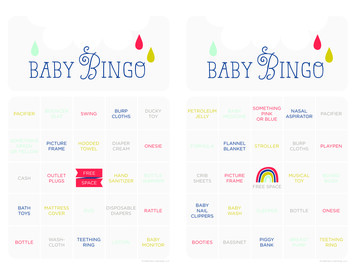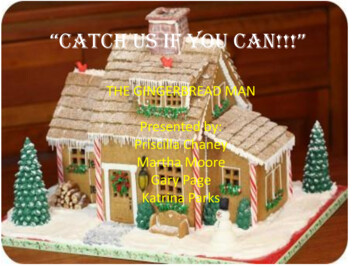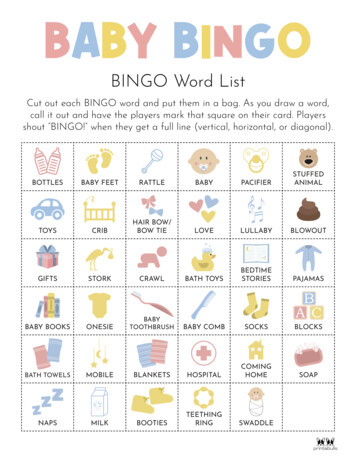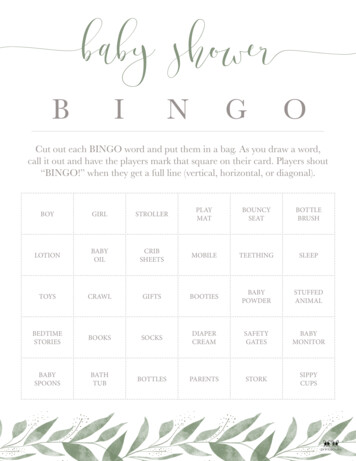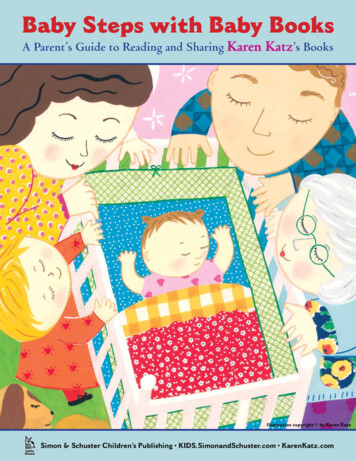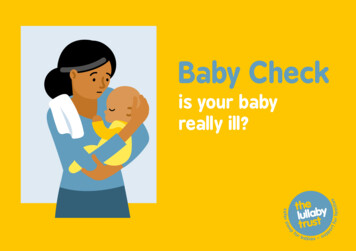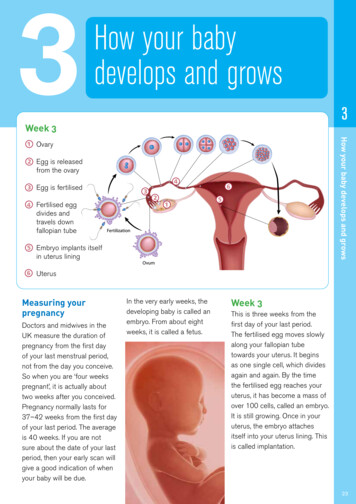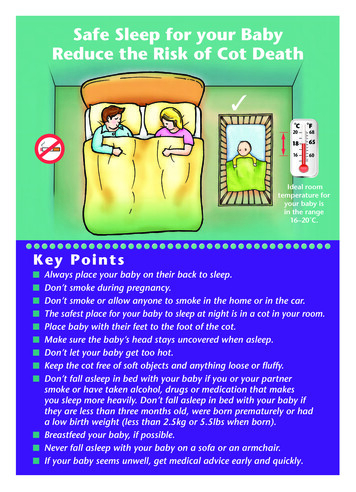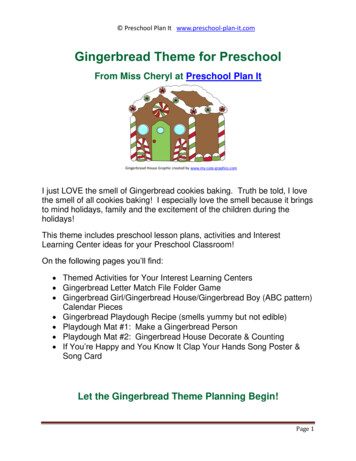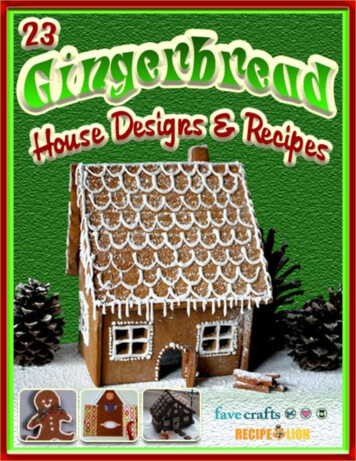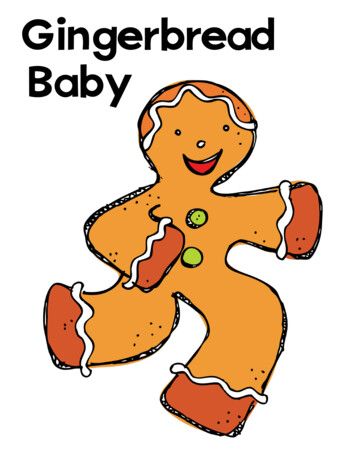
Transcription
GingerbreadBaby
Gingerbread BabyBook by Jan BrettUnit Study by AmiLanguage ArtsMemory GameAfter you read the book, close it. Ask your child who the gingerbread baby gotaway from and see how many of the people/animals he is able to remember. Witha younger child, you may want to simply ask what animals he remembers from thebook. Do this on a few different days to see if your child's memory improves.DramaPrint the animal masks and act the story out with your child(ren). Dad may join in,too! Another variation of this would be to make puppets and let your children puton a puppet show as they re-enact the story.Critical ThinkingMatti was very clever in how he caught the Gingerbread Baby. Ask your student ifhe can think of a different way to catch that Gingerbread Baby. Your youngerstudent may simply narrate it for you while your older student may want to write itin a story form.Vocabularymeddling- to interest oneself in what is not one's concernsnout- a long nose or muzzleworn- old, usedpranced- dancedtumbled- fell overtabby- a cat with a striped and spotted coattwitched- to move with sudden motionwhiff- smellComplete the vocabulary shapes and add them to your lapbook.Folk TalesThis story is a folk tale. It isn't a true story. What parts of this story are make-
believe? What parts are like real life?If you have an older student, you may want to have him make a list of familiar folkand fairy tales. Can you go to the library and find many different versions of thesame tale? Your student may also be able to make a list of folk tale characteristics.A good tale to add on to this study would be Hansel and Gretel (because of thecandy house connection).Record your student's narration of Hansel and Gretel in the mini-book and put it inyour lapbook.Compare and Contrast Two StoriesRead other versions of this classic tale together and discuss what is the same/whatis different. Your older child may want to make a chart or a Venn diagram. Afteryou read multiple versions, your student may want to try writing (or narrating) hisown version.Elements of a StoryLook through the printables section to find the mini books for plot, character, andsetting. Discuss these elements with your student and complete the books.Social StudiesLiving in a Different Time EraWhat are some differences in the way things are in this story vs. the way things arein real life? Mom has a real fire under her stove and firewood in the houseThere are candles hanging on the wall for light-- no electricityHorse/WagonThe MilkmanWhat other examples can you and your student find?GeographyMap out where the different ingredients (for gingerbread) come from.
History of GingerbreadGingerbread has been baked in Europe for centuries.In some places, it was a soft, delicately spiced cake; in others, a crisp, flat cookie,and in others, warm, thick, steamy-dark squares of "bread," sometimes servedwith a pitcher of lemon sauce or whipped cream. It was sometimes light,sometimes dark, sometimes sweet, sometimes spicy, but it was almost always cutinto shapes such as men, women, stars or animals, and colorfully decorated orstamped with a mold and dusted with white sugar to make the impression visible.The manufacture of gingerbread appears to have spread throughout WesternEurope at the end of the eleventh century, possibly introduced by crusadersreturning from wars in the Eastern Mediterranean. From its very beginninggingerbread has been a fairground delicacy. Many fairs became known as"gingerbread fairs" and gingerbread items took on the alternative name in Englandof "fairings" which had the generic meaning of a gift given at, or brought from, afair.Certain shapes were associated with different seasons: buttons and flowers werefound at Easter fairs, and animals and birds were a feature in autumn. There is alsomore than one village tradition in England requiring unmarried women to eatgingerbread "husbands" at the fair if they are to stand a good chance of meeting areal husband.Gingerbread-making was eventually recognized as a profession in itself. In theseventeenth century, gingerbread bakers had the exclusive right to make it, exceptat Christmas and Easter. Their street cries could be heard well into the nineteenthcentury, but by 1951, only two men in London had their own gingerbread for salein the streets.Of all the countries in Europe, Germany is the one with the longest and strongesttradition of flat, shaped gingerbreads. At every autumn fair in Germany, and in thesurrounding lands where the Germanic influence is strong, there are rows of stallsfilled with hundreds of gingerbread hearts, decorated with white and colored icingand tied with ribbons.Gingerbread making in North America has its origins in the traditions of the manysettlers from all parts of Northern Europe who brought with them family recipes
and customs. By the nineteenth century, America had been baking gingerbread fordecades. American recipes usually called for fewer spices than their Europeancounterparts, but often made use of ingredients that were only availableregionally. Maple syrup gingerbreads were made in New England, and in the Southsorghum molasses was used.Nowhere in the world is there a greater repertoire of gingerbread recipes than inAmerica: there are so many variations in taste, form and presentation. With therich choice of ingredients, baking aids and decorative items, the imaginative cookcan create the most spectacular gingerbread houses and centerpieces ever.Source: www.hungrymonster.comScience & MathMake Gingerbread Cookies"They measured and mixed."Just like Matti and his mom in the book, make some gingerbread cookies with yourchild. Let your child do the measuring and mixing (as much as possible). Let him dothe things he can do even if it makes a little more mess or takes a little more ofyour time. You may want to discuss with your child the importance of followingdirections. What happens if you add to much flour or too much sugar? What wouldhappen if you decided to leave out the baking soda? If you have an older childworking along-side your preschooler, you may want to allow him to make somepredictions on a chart and let him make some cookies that don't follow thedirections. What were the results? (too hard, too soft, etc.). What happened toMatti when he didn't follow directions?For an extra math connection, have your student make patterns on his gingerbreadcookies (with M&Ms or other candies). Can he finish a pattern that you start? Canyour older student start a pattern for your younger student?Just for FunGingerbread Mix In a JarThis is a wonderful gift to make for friends and family!
Ingredients:2 cups all-purpose flour1 teaspoon baking powder1 teaspoon baking soda1 1/2 cups all-purpose flour2 teaspoons ground ginger1 teaspoon ground cloves1 teaspoon ground cinnamon1 teaspoon ground allspice1 cup packed brown sugarDirections: Mix 2 cups of the flour with the baking soda and baking powder. Mixthe remaining 1 1/2 cups flour with the ginger, cloves, cinnamon, and allspice. In a1 quart, wide mouth canning jar, layer the ingredients starting with the flour andbaking powder mixture, then the brown sugar, and finally the flour and spicemixture. Pack firmly between layers. Attach a directions tag to the jar.Make a Gingerbread HouseAfter you make your gingerbread people, you are going to need a place for them tolive! Whether you make it out of real gingerbread or graham crackers, your childwill enjoy the time you spend together!Recipe for "Gingerbread" PlaydoughThis is an easy dough to make. Your child can have fun helping you. Maybe he willmake a gingerbread baby and gingerbread house to play with.1 cup flour1/2 cup salt2 tsp. cream of tartar1 cup water1 tsp. vegetable oilSpices: Cinnamon, Ginger, Allspice, Nutmeg (I add a lot of cinnamon--probably 1/4cup plus a tiny bit of ginger and nutmeg)Mix the dry ingredients. In a separate bowl mix water and oil together then addthem to the dry ingredients and stir. In a pot, cook the mixture for three to fiveminutes on low/medium, stirring constantly. The dough will start to pull away from
the sides of the pot and stick together in a large ball. Take the dough out of thepan and knead the dough until it becomes soft and smooth. Allow the dough tocool and then store it in an airtight container.Christmas Ornament Dough1/2 cup apple sauce1/2 cup cinnamonZiploc bagrolling pinChristmas cookie cuttersRed/Green Yarn or Clear Fishing LinePour cinnamon and apple sauce into the bag. Seal and knead until a dough forms.Roll the dough out with the cookie cutters. Remember to cut a hole at the top ofyour "cookie" before it dries (to thread the yarn through). Let it dry overnight andgive as gifts or hang on your tree. If you have leftovers, store it in the plastic bagfor later.Library ListMaisy Makes Gingerbread (for preschoolers)Gingerbread Man by Karen Lee SchmidtGingerbread Boy by Richard EgielskiThe Gingerbread Rabbit by Randall JarrellThe Gingerbread Man retold by Jim AylesworthYou Can’t Catch Me by John and Ann HassettThe Cajun Gingerbread Boy by Berthe AmossThe Runaway Tortilla by Eric KimmelThe Gingerbread Girl by Lisa Campbell ErnstThe Gingerbread Cowboy by Janet SquiresThe Pancake Man: An Old Norwegian Folk Tale by Lorinda CauleyMaterials and information on this website may be used for your own personal andschool use. Material may not be shared electronically or be used for resale. Homeschool Share
My gingerbread recipeCut book out as one piece. Fold opposite of a matchbook (the small flapwith “My Gingerbread Recipe” should be at the top of the book instead ofthe bottom). Include a favorite recipe in this book OR let your studentdictate how to make gingerbread and record his narration in the book.
Cut out shapes. Let your student write the correct word on each piece. Stack together and attach at thetop with a staple or brass fastener. For extra durability, print on cardstock.Vocabularyto interestoneself inwhat is notone'sconcerna long noseor muzzleold and used
danceda cat with astriped andspotted coatfell overto move withsuddenmotion
smell
Cut on solid black lines to remove extra areas. Fold leftover paper into thirds (tri-fold style). Write a different title of each storyyou’ve read on each gingerbread person. Let your student list the characters mentioned in each different story. Use this as aspringboard for character and what characters are. You can also use it to compare and contrast the various versions you’ve read.character
Cut out book as one piece. Fold tri-fold style. Use each page to list the title of a gingerbreadthemed book read as well as the setting found in the story.Setting
Cut book out as onepiece. Fold in half. Usethe inside to recordyour student’s narrationof the story.Hansel and Gretel
TheplotCut book out on solid blacklines. Fold on dotted lines.This will be your cover.
ConflictWhat is the mainproblem in thestory?Rising ActionWhat events arecreated by theproblem?How do thecharacters try tosolve the problem?ClimaxWhat is the mostexciting moment ofthe story?DenouementWhat was the finalsolution to theproblem?How does the storyend?Cut on solid black lines.Fold on dotted lines. Youshould have four smallbooks when finishedcutting and folding.Let your student write theanswer to the questioninside each book. Gluethe books inside thecover book.
Cut book out as one piece. Fold each triangle under. Fold book in half on solid black line. Open thebook and you should see four flaps. Let your student write his answers under each flap.
You can’tcatch me!Cut book on next page out as one piece. Let your student complete thehandwriting exercise. When finished, fold in half.Cut cover piece out (on this page) and affix to the front of the book.
Run, run, as fast asyou can! You can’tcatch me. I’m theGingerbread Man!
Run, run, as fast asyou can! You can’tcatch me. I’m theGingerbread Man!
My gingerbreadfamily
Wordswith thehard GSTORAGEWordswith thesoft Gg isfor
Cut the book out in one piece (along the solid outer lines).Cut the cards apart.Fold the short edge of the book up along the dotted line so that the text is to the outside. Attach the pocket tothe main portion of the book (on the right and left sides) using a thin strip of adhesive.Fold the “words with soft G” portion of the book over along the dotted line so that the pocket is on the inside.Do the same with the “words with hard G” portion of the he center pocket allows your student a storage spot so he can play this “game” over and over.
One YummyGingerbread ManEat one yummy leg,Eat the other yummy leg.Eat one tasty arm.
Eat the other tasty arm.Crunch. Munch. Crunch.Yummy in your tummy!Eat the delicious head.
Cut pages apart. Let your student decorate the five gingerbread patterns. Let your student rip the armoff of one. Glue that one to the first page. Let your student rip both arms off the second. Glue that tothe next page. Continue ripping off body parts (lol) until your student has “eaten” the arms, legs, andhead. Use the ripped parts on the last page (crunch.munch).Have fun with this! :) Once the pages are finished, you can stack together and staple on the left side ofthe cover.
Cut out cards. Let your student sequence the cards or use them toretell the story. If desired, make a small book from the cards.Please note that these cards go with the original version of the story.
Mystory
Measure and mix!Roll the dough flatAdd pictures of your cookie baking experience!Cut out all three strips of three rectangles. Glue where indicated so that you have one long line. Fold accordion style makingsure “Making Gingerbread” is on the front cover. Before you glue the back of the last page into your lapbook, affix a ribbonaround the book (glue it down to the back as well) that can tie on the front to help keep your book closed.Makinggingerbread
Glue to the back of the last page.Cut out the shapesTime to bake!
Glue to the back of the last page.DecoratingCatching gingerbread
Fold in half on the dotted line. Cut around the shape of the book. Cut out the word find and word list on the next page. Paste the word find on one sideof the house and the word list on the other. You could easily use this house for something else if your student isn’t ready for or doesn’t enjoy word puz-
GPIBVCDEASMBVAPHLHORSECKCCAENLATGREFLFGBTRSGBAN MW PYDNW EDTOJESAHV M CGUFTSAES WONKPM CUYEIKLN M QO WHRGingerbread Word OXMANBAKECANDYICINGYUMWORD LIST
Gingerbread Cookies1. Empty contents of jar into a large mixing bowl. Stir to blend together. Mix in 1/2 cupsoftened butter or margarine, 3/4 cup molasses, and 1 slightly beaten egg. Dough will bevery stiff, so you may need to use your hands. Cover, and refrigerate for 1 hour.2. Preheat oven to 350 degrees F (175 degrees C). 3. Roll dough to 1/4 inch thick on alightly floured surface. Cut into shapes with a cookie cutter. Place cookies on a lightlygreased cookie sheet about 2 inches apart. 4. Bake for 10 to 12 minutes in preheatedoven.Gingerbread Cookies1. Empty contents of jar into a large mixing bowl. Stir to blend together. Mix in 1/2 cupsoftened butter or margarine, 3/4 cup molasses, and 1 slightly beaten egg. Dough will bevery stiff, so you may need to use your hands. Cover, and refrigerate for 1 hour.2. Preheat oven to 350 degrees F (175 degrees C). 3. Roll dough to 1/4 inch thick on alightly floured surface. Cut into shapes with a cookie cutter. Place cookies on a lightlygreased cookie sheet about 2 inches apart. 4. Bake for 10 to 12 minutes in preheatedoven.
Terms of Use:This product may be used for your own classroom or personal use. Itmay not be shared as a pdf file, on the web, or in any other way. Homeschool ShareLapbook Copyright Thanks:KPM Doodles
Cut book out as one piece. Fold opposite of a matchbook (the small lap with “My Gingerbread Recipe” should be at the top of the book instead of the bottom). Include a favorite recipe in this book OR let your student dictate how to make gingerbread and record his narr
